UV systems for use in industrial water treatment
Ultraviolet radiation is an effective medium for water disinfection and degradation of photochemically active water constituents. The high-energy radiation in the wavelength range of 200 to 300 nm damages the DNA of bacteria, viruses, protozoa and spores, terminates the reproduction of microorganisms and enables to ensure hygienic water.
UV-C radiation is also suitable for eliminating dissolved ozone, which adsorbs the radiation at 254 nm and photolytically decomposes to oxygen. The elimination of chlorine dioxide dissolved in water is possible in the range of an adsorption maximum of 350 nm. A special feature is the elimination of TOC (Total Organic Carbon) in ultrapure water at an energy-rich 185 nm wavelength: Highly reactive OH radicals (hydroxyl radicals) form in the irradiated water and oxidatively decompose the organic molecules.
The process combination of UV irradiation with oxidants, such as hydrogen peroxide or ozone, is called Advanced Oxidation Process AOP and is used for the elimination of poorly degradable organic substances, especially in special wastewater.
Due to different system requirements, low-pressure and medium-pressure UV emitters are used in practical applications, which are installed in specially designed stainless steel flow-through or immersion reactors for reliable, environmentally friendly water treatment.
Important fields of application for UV technology are:
- Drinking water: Eliminating microorganisms, among other things, in combination with filter techniques and membrane systems; Legionella prophylaxis and biofilm prevention in water reservoirs and pipe networks.
- Ultrapure water in the semiconductor industry: Reduction of TOC with 185 nm emitters to prevent production quality and disinfection of vessels and ring lines.
- Ultrapure water in the pharmaceutical industry: degradation of dissolved ozone in cold storage and distribution systems disinfected and sanitized with ozone.
- Swimming pools / pools: water disinfection with chlorine savings; degradation of combined chlorine with medium pressure emitters.
- Process water disinfection in the food and beverage industry: Degradation of excess chlorine dioxide, e.g. from the CIP process.
- Cooling water treatment at recooling plants to reduce algae growth and biofilm formation.
- Aquariums and fish ponds: Destruction of parasites and algae to prevent fish diseases.
- Advanced Oxidation Process AOP: Eliminating poorly degradable organic substances in wastewater through the combination effect of UV and OH radicals or oxidizing agents, such as ozone or H2O2.
Two different UV lamp variants are usually used in the UV systems:
- Mercury and amalgam low-pressure emitters with UV emission maximum at 254 nm and another line at 185 nm; single emitters in the range of 6 – 320 W
- Adjustable medium-pressure emitters with broad spectrum and emission lines between approx. 250 and 580 nm and high energy density; system range from 400 W to 20 kW
The standardized UV systems offered by HeylNeomeris are mainly used in the treatment of drinking water, swimming pool water, cooling water and industrial process and ultrapure water. The systems consist of the stainless steel reactor in different material qualities, UV lamps in the quartz immersion tube and a control cabinet with ballasts and, depending on the design, a UV monitoring monitor. Special plants or UV reactors with special connections can be designed according to customer specifications.
The professional POOL NS UV systems are specially designed for private pools and hotel pools and consist of stainless steel reactors in 1.4571 quality and low-pressure lamps (80 W and 125 W) for water disinfection (250 J/m2 UV dose) in pools of approx. 50 and 75 m3 capacity.
The POOL MS series uses powerful medium pressure lamps (650 to 5000 W) in stainless steel 1.4571 reactors for the reduction of chloramines and other skin irritants. The reactors are designed for flow rates between 14 and 247 m3/h at 600 J/m2 UV dose. The units are equipped with a multi-functional control system with UV monitor and UV sensor according to DVGW guidelines.
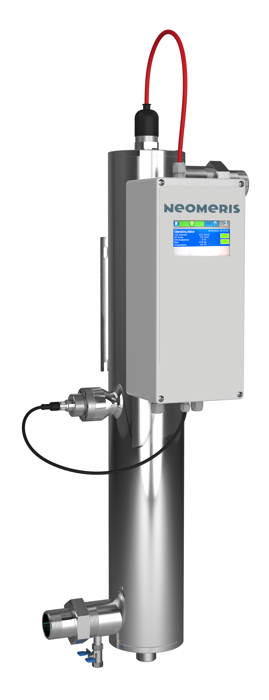
In Germany, only UV systems that have been tested and certified in accordance with worksheet DVGW W294 may be used for drinking water disinfection. The focus is on reliable and continuous irradiation of the water to be treated to ensure the degradation of microorganisms, especially bacteria and legionella. The units are equipped with certified and calibrated UV sensors. The reactors are made of 1.4404 stainless steel and are equipped with low-pressure radiators in the range of 35 to 265 W. The flow rate range is from 1.3 m3/h to 26.3 m3/h based on the required UV radiation dose of 400 J/m2 (90% / 1 cm UV transmission). The HOT series is used especially in drinking water installations of residential buildings up to 60 °C water temperature.
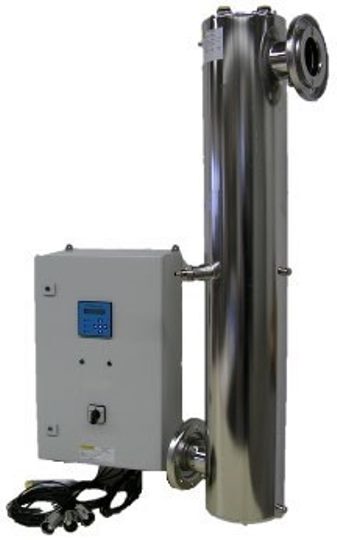
This particularly low-cost series is suitable for a wide range of applications in water treatment, especially when DVGW drinking water certification is not required or there are no special material requirements, such as in the food and pharmaceutical industries. The plants are installed in recooling plants, e.g. to prevent biofilm and legionella growth. The plants consist of stainless steel reactors in 1.4571 quality and low-pressure emitters, which are offered in single and multiple emitter versions. The series covers a flow range up to 145 m3/h based on a radiation dose of 400 J/m2 at 98 % / 1 cm UV transmission. Optionally, the units are available with a UV sensor system and temperature monitoring in the reactor.
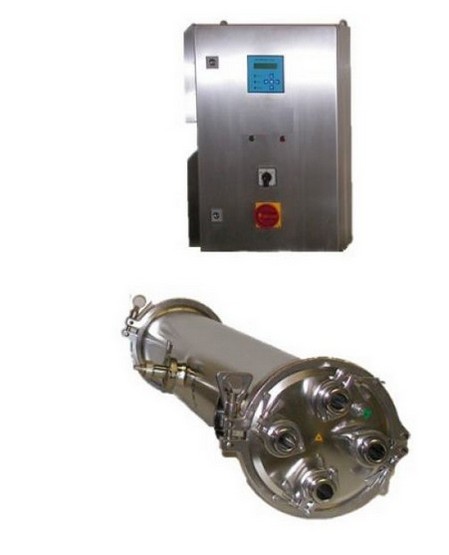
This series meets the standards of the food and beverage industry in terms of material quality and design. The reactor is made of stainless steel 1.4571 or 1.4404, electropolished outside and inside and equipped with TriClamp connections according to DIN 32676 (alternative on request). The disinfection of raw water, process water and liquid products requires reliable irradiation technology in single or multi-radiator reactors with integrated UV monitoring technology. Temperature monitoring in the reactor is available as an option. This model series covers an operating range from 0.7 m3/h to 28.5 m3/h flow based on a radiation dose of 800 J/m2 at 98 % / 1 cm UV transmission. More powerful UV reactors are additionally available.
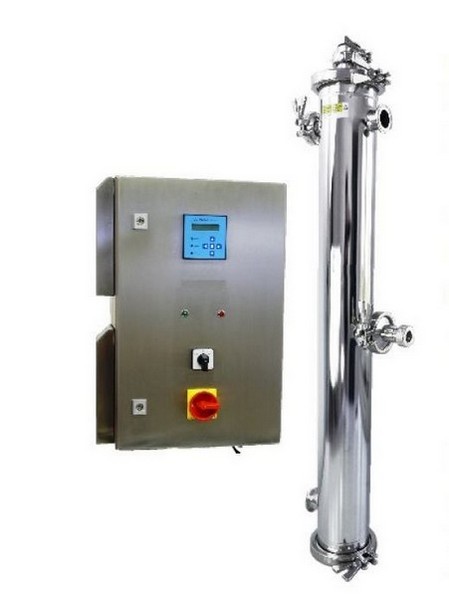
The PHARMA series includes high-end UV systems that meet GMP and FDA requirements for use in high-purity water in the pharmaceutical and health care industries. The stainless steel reactors are manufactured from 1.4404 or optionally from 1.4435, are electropolished inside and out and can be machined to surface roughnesses < 0.8 to < 0.4 µm. The design of the reactor allows residual drainability, is low in dead space and has TriClamp connections according to DIN 32676 as standard (alternatives possible!). The disinfection and especially the residual ozone destruction of PW, HPW and WFI in the storage and distribution system usually requires a validatable UV system, which is usually designed for higher radiation intensities of more than 1000 J/m2. The systems with single and multi-radiator reactors, calibrated UV sensors according to DVGW / ÖNORM and optional temperature monitoring cover a flow range up to approx. 50 m3/h at 1200 J/m2 radiation dose and 98 % / 1 cm UV transmission. In addition, more powerful reactors or special design are available.
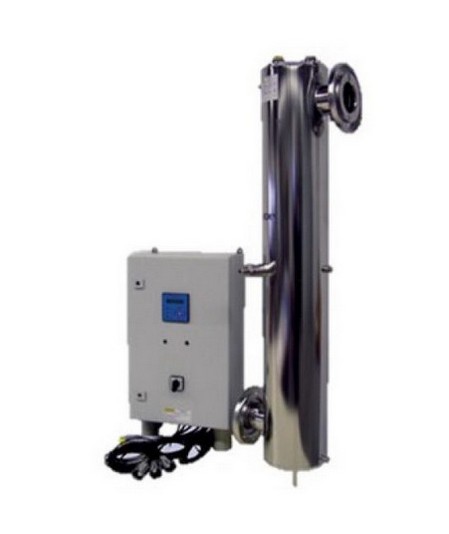
The organic carbon content (TOC) dissolved in ultrapure water is a very important parameter for the quality of production and cleaning processes in the semiconductor and electronics industry. UV technology is used to reduce the TOC in ultrapure water, which is already retained by reverse osmosis/EDI, to a few ppb as far as possible. The high-energy UV emission line at 185 nm generates highly reactive OH radicals in the water that oxidatively degrade organic carbon molecules. The TOC
series has special low-pressure emitters made of Suprasil glass in the noble beam reactor made of 1.4571 with flange connections according to DIN 2576 (alternatives possible) and optionally with light traps for suitable mounting in plastic pipes. The flow range up to approx. 30 m3/h with single and multi-beam reactors is covered with reference to a powerful UV radiation dose of 1600 J/m2 at a transmission of 98 % / 1 cm. Special units for higher flow rates and radiation densities are available.
We are happy to provide customer-specific advice and support in plant planning, construction and commissioning. Our qualified personnel is also specialized in service and maintenance of the equipment technology incl. personnel training.
For more information on UV systems and maintenance and service offerings, visit: